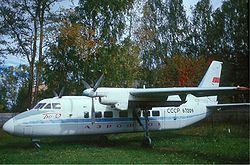Beriev Be-32
| Beriev Be-32 | |
|---|---|

|
|
| Type: | Passenger plane |
| Design country: | |
| Manufacturer: | |
| First flight: |
1969 |
The Beriev Be-32 ( Russian Бериев Бе-32 ) is a twin-engine aircraft produced by the Soviet , now Russian, manufacturer Beriev . The first flight of the self-supporting shoulder- wing wing took place in 1969. The machine is a Beriev Be-30 equipped with 17 passenger seats .
construction and development
The machine, made entirely of metal, is powered by two turboprop engines attached to the leading edge of the wing. The wing has a slightly negative V-shape on the outer wing pieces. The spar is milled. Chemical processes were also used. The detachable wing nose consists of a glued construction. About half of the wing is made of a sandwich honeycomb construction . Double-slit landing flaps are used to improve slow flight characteristics. The machine has STOL properties. The nose wheel landing gear is retractable. The wing, tail unit and the air inlets are heated by the engine bleed air to prevent ice accumulation. The windshield and the three-bladed propellers, 3 m in diameter, have an electrical heating system.
The avionics are sufficient to be able to fly in all weather conditions. Autopilot and ILS are standard. The Be-32 also has a system that automatically compensates for crosswinds during take-off and landing.
history
The Be-30 was in direct competition with the Antonow An-28 . In a comparison flight for Aeroflot, both types performed well. But there were no significant orders. Aeroflot chose the Let L-410 . So only three series machines were produced. In 1976 the machine set two world records for climbing time in its class (II C-1). Yevgeny Lachmostow flew the machine at 3,000 m in 2 min 24.849 s and at 6,000 m in 5 min 18 s. Then began a change in the program. The planned Gluschenko TWD-10 engines should be exchanged for Gluschenko TWD-20 engines. However, Gluschenko was busy with production for the military sector for years.
After 1985, the decision was made to set up a joint venture between Pratt & Whitney and Klimow , so that the PT6A-65 was manufactured under license . This type was built into the Be-32. The machine, equipped with Hartzell four-blade propellers and now called the Be-32K , was exhibited at the Paris Air Show in 1993 in the colors of Moscow Airways . The company initially ordered 50 aircraft of this type, but later withdrew from the order.
The multi-purpose aircraft can be used for passenger and freight transport as well as for coastal, border, forest and water protection tasks. In addition, because of the robust chassis, it is also intended to be used as a means of transport for bush doctors or for transporting important medicines. Parachutists can also be dropped off with the machine. The aircraft is extremely manoeuvrable and can even fly some aerobatic maneuvers when empty.
Technical specifications
| Parameter | Data |
|---|---|
| crew | 2 |
| Passengers | 17 or 1900 kg freight |
| length | 15.70 m |
| span | 17.00 m |
| height | 5.46 m |
| Wing area | 32 m² |
| Cabin length | 6.0 m |
| Cabin height | 1.82 m |
| Cabin width | 1.55 m |
| Capacity of the luggage compartment | 1.33 m³ |
| Empty mass | 4600 kg |
| Max. Takeoff mass | 7600 kg |
| Take-off run | 430 m |
| Landing runway | 240 m |
| prescribed runway length | 830 m |
| Top speed | 510 km / h at an altitude of 2000 m |
| Cruising speed | 480 km / h |
| economical cruising speed | 370 km / h |
| Start speed | 180 km / h |
| Landing speed | 170 km / h |
| Service ceiling | 4200 m |
| Range with maximum payload | 885 km |
| Range with maximum fuel | 2050 km |
| drive | 2 Pratt & Whitney / Klimow PT6A-65B |
| power | 810 kW (1,101 PS) each |
Web links
Individual evidence
- ↑ Fliegerrevue 2/1989 4th cover page